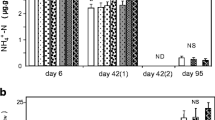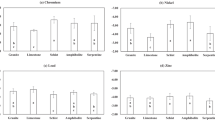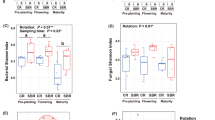Abstract
Microcosms containing intact soil-cores are a potential biotechnology risk assessment tool for assessing the ecological effects of genetically engineered microorganisms before they are released to the field; however, microcosms must first be calibrated to ensure that they adequately simulate key field parameters. Soil-core microcosms were compared with the field in terms of ecological response to the introduction of a large inoculum of a rifampicin-resistant rhizobacterium,Pseudomonas sp. RC1. RC1 was inoculated into intact soil-core microcosms incubated in the laboratory at ambient temperature (22°C) and in a growth chamber with temperature fluctuations that mimicked a verage field values, as well as into field lysimeters and plots. The effect of the introduced bacterium on ecosystem structure, including wheat rhizoplane populations of total and fluorescent pseudomonads, total heterotrophic bacteria, and the diversity of total heterotrophic bacteria, was determined. Fluorescent pseudomonads were present on the rhizoplane in significantly lower numbers in soil inoculated with RC1, in both microcosms and the field. Conditions for microbial growth appeared to be most favorable in the growth chamber microcosm, as evidenced by higher populations of heterotrophs and a greater species diversity on the rhizoplane at the three-leaf stage of wheat growth. Ecosystem functional parameters, as determined by soil dehydrogenase activity, plant biomass production, and15N-fertilizer uptake by wheat, were different in the four systems. The stimulation of soil dehydrogenase activity by the addition of alfalfa was greater in the microcosms than in the field. In general, growth chamber microcosms, which simulated average field temperatures, were better predictors of field behavior than microcosms incubated continuously at 22°C.
Similar content being viewed by others
References
Atlas RM (1984) Diversity of microbial communities. Adv Microb Ecol 7:1–47
Atlas RM, Bartha R (1987) Microbial ecology, 2nd ed. Benjamin/Cummings Publ. Co., Menlo Park, CA
Bentjen SA, Fredrickson JK, Li SW, Van Voris P (1989) Intact soil-core microcosms for evaluating the fate and ecological impacts from the release of genetically engineered microorganisms. Appl Environ Microbial 55:198–202
Bolton H Jr, Elliott LF (1989) Toxin production by a rhizobacterialPseudomonas sp. that inhibits wheat root growth. Plant Soil 114:269–278
Bolton H Jr, Elliott LE, Turco RF, Kennedy AC (1990) Rhizoplane colonization of pea seed byRhizobium leguminosarum and a deleterious root colonizingPseudomonas sp. and effects on plant growth. Plant Soil 123:121–124
Bolton H Jr, Fredrickson JK, Bentjen SA, Workman DJ, Li SW, Thomas, JM (1991) Field calibration of soil-core microcosms: Fate of a genetically altered rhizobacterium. Microb Ecol 21:163–173
Cairns J, Pratt JR (1986) Ecological consequence assessment: Effects of bioengineered organisms. In: Fiskel J, Covello VT (eds) Biotechnology risk assessment, issues and methods for environmental introductions. Pergamon Press, New York, pp 88–108
Dean-Ross D (1986) Release of genetically engineered microorganisms: Hazard assessment. ASM News 11:572–575
Fredrickson JK, Bentjen SA, Bolton H Jr, Li SW, Van Voris P (1989) Fate of Tn5 mutants of root growth-inhibitingPseudomonas sp. in intact soil-core microcosms. Can J Microbiol 35:867–873
Fredrickson JK, Bolton H Jr, Bentjen SA, McFadden KM, Li SW, Van Voris P (1990) Evaluation of intact soil-core microcosms for determining potential impacts on nutrient cycling dynamics by genetically engineered microorganisms. Environ Toxicol Chem 9:551–558
Fredrickson JK, Elliott LF (1985) Colonization of winter wheat roots by inhibitory rhizobacteria. Soil Sci Soc Am J 49:1172–1177
Fredrickson JK, Koehler FE, Cheng HH (1982) Availability of15N-labeled nitrogen in fertilizer and in wheat straw to wheat in tilled and no-tilled soil. Soil Sci Soc Am J 46:1218–1222
Fredrickson JK, Van Voris P, Bentjen SA, Bolton H Jr (1990) Terrestrial microcosms for evaluating the environmental fate and risks associated with the release of chemicals or genetically engineered microorganisms to the environment. Hazard Assess Chem-Curr Develop 7:157–202
Gillett JW, Witt JM (1979) Terrestrial microcosms. In: Proceedings of the workshop at Otter Rock and Portland, OR, June and December 1977. NSF/RA-790034. National Science Foundation, Washington, D.C., 34 p
Hauck RD, Bremner JM (1976) Use of tracers for soil and fertilizer nitrogen research. Adv Agron 28:219–266
Jackson DR, Levin M (1979) Transport of arsenic in grassland microcosms and field plots. Water Air Soil Pollut 11:3–12
Lindow SE (1987) Competitive exclusion of epiphytic bacteria by ice− Pseudomonas syringae mutants. Appl Environ Microbiol 53:2520–2527
Martin JK (1975) Comparison of agar medium for counts of viable soil bacteria. Soil Biol Biochem 7:401–402
Murdoch CW, Campana RJ, Hoch J (1984) The biological control ofCeratocystis ulmi withPseudomonas fluorescens. Phytopathology 74:805
Omenn GS (1986) Controlled testing and monitoring methods for microorganisms. In: Fiskel J, Covello VT (eds) Biotechnology risk assessment, issues and methods for environmental introductions. Pergamon Press, New York, pp. 144–163
O'Neill E, Hood M, Cripe C, Pritchard P (1988) Field calibration of aquatic microcosms In: Abstract of the annual meeting of the American society for microbiology, American Society for Microbiology, Washington, D.C., p 297
Pritchard PH (1982) Model ecosystems. In: Conway RA (ed) Environmental risk analysis for chemicals. Van Nostrand Reinhold Co., New York, pp 257–353
Pritchard PH, Bourquin AW (1984) The use of microcosms for evaluation of interactions between pollutants and microorganisms. Adv Microb Ecol 7:133–217
Sands DC, Rovira AD (1970) Isolation of fluorescent pseudomonads with a selective medium. Appl Microbiol 20:513–514
Scher FM, Baker R (1982) Effect ofPseudomonas putida and a synthetic iron chelator on induction of soil suppressive toFusarium wilt pathogens. Phytopathology 72:1567–1573
Schmidt EL, Belser LW (1982) Nitrifying bacteria. In: Page AL, Miller RH, Keeney DR (eds) Methods of soil analysis. Part 2. Chemical and microbiological properties, second ed. American Society of Agronomy, Madison, WI, pp 1027–1042
Shannon CE, Weaver W (1963) The mathematical theory of communication, University of Illinois Press, Urbana
Steel RGD, Torrie JH (1980) Principles and procedures of statistics: A biometrical approach, 2nd ed. McGraw-Hill, New York
Stevenson FJ (1986) Cycles of soil: Carbon, nitrogen, phosphorus, sulfur, micronutrients. John Wiley & Sons, New York
Strauss HS, Hattis D, Page G, Harrison K, Vogel S, Caldert C (1986) Genetically-engineered microorganisms: II. Survival, multiplication, and genetic transfer. RAC Tech Bull 9:16–28
Tabatabai MA (1982) Soil enzymes. In: Page AL, Miller RH, Keeney DR (eds) Methods of soil analysis. Part 2. Chemical and microbiological properties, 2nd ed. American Society of Agronomy, Madison, WI, pp 903–947
Tiedje JM (1982) Denitrification. In: Page AL, Miller RH, Keeney DR (eds) Methods of soil analysis. Part 2. Chemical and microbiological properties, 2nd ed. American Society of Agronomy, Madison, WI, pp 1011–1026
Tiedje JM, Colwell RR, Grossman YL, Hodson RE, Lenski RE, Mack RN, Regal PJ (1989) The planned introduction of genetically engineered organisms: Ecological considerations and recommendations. Ecology 70:298–315
Tolle DA, Arthur MF, Chesson J, Van Voris P (1985) Comparison of pots versus microcosms for predicting agroecosystem effects due to waste management. Environ Toxicol Chem 4:501–509
Tolle DA, Arthur MF, Van Voris P (1983) Microcosm/field comparison of trace element uptake in crops grown in fly-ash amended soil. Sci Tot Environ 4:501–509
Weller DM (1983) Colonization of wheat roots by a fluorescent pseudomonad suppressive to take-all. Phytopathology 73:1548–1553
Weller DM (1984) Distribution of a take-all suppressive strain ofPseudomonas fluorescens on seminal roots of winter wheat. Appl Environ Microbiol 48:897–899
Author information
Authors and Affiliations
Rights and permissions
About this article
Cite this article
Bolton, H., Fredrickson, J.K., Thomas, J.M. et al. Field calibration of soil-core microcosms: Ecosystem structural and functional comparisons. Microb Ecol 21, 175–189 (1991). https://doi.org/10.1007/BF02539152
Received:
Revised:
Issue Date:
DOI: https://doi.org/10.1007/BF02539152




